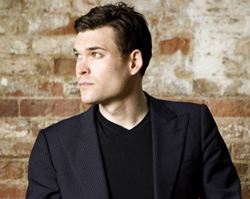by Daniel Hathaway

With his Études-Tableaux, Wigglesworth is completing his second and final year as Daniel R. Lewis New Composer Fellow with the Orchestra. He has written that the “Study Pictures” make use both of musical ideas from a piece he began earlier but withdrew, and ideas that look forward to an opera he’s writing on Shakespeare’s A Winter’s Tale for the English National Opera in 2017. In an interview for this publication, he said that his new work “has a very specific structural aim — having its ‘little windows’ of thematic and harmonic ideas join up to make an arc. Of course, I hope that the listener won’t see it as a set of little windows but will hear the line that goes through it.”
The thirteen-minute work calls for a large orchestra with double winds, harp, celesta, and ample percussion, but in contrast to the billowy soundscapes many contemporary composers fall into writing because they have so many instruments at their disposal, Wigglesworth writes within a clear formal structure and deploys his forces economically. Thematic ideas are clearly laid out and return in identifiable if altered versions. He uses percussion judiciously and surprises the ear with such simple touches as a sudden clarinet solo that becomes a duet. Like Boulez, he writes music from the viewpoint of a conductor who knows the orchestra and knows what he wants it to do.
Franz Welser-Möst and the Orchestra played Études-Tableaux with clarity and commitment, and the work and its composer were greeted warmly by the audience. Had the symphony that followed not been a 75-minute affair, it would have been illuminating to hear the new piece twice.
After an intermission longer than the first half of the concert came the spectacular sonic onslaught of the march that opens Mahler’s Symphony No. 6. Interrupted several times by arresting episodes (for low winds and contrabassoon, for an expansive string section interlude, for wonderful horn and clarinet solos by Richard King and Franklin Cohen, for mellow commentary by nine gleaming horns) the march kept reigniting like a hastily-doused fire.
The string section, wind solos and cowbells dominated the second-movement Andante, while shivering wind trills, rude horn blarings, and clarion-like calls in the clarinets added striking touches to the Scherzo.
A moment of sheer magic — with stardust from the celesta and a surprising tuba solo excellently played by Yasuhito Sugiyama — opened the finale, which handily outlasted the first three movements and contained every musical gesture and effect you could think of. And some you couldn’t have imagined, like the “hammer,” a square-headed bludgeon with a long handle that principal percussionist Marc Demoulakis — executioner-like — twice brought down on a black wooden box upstage.
Retiring to his summer composing shed in the woods at Maiernigg after a busy season in Vienna, Mahler must have had a lot of music in his head that he needed to get out and put down on paper. So much music that ending this symphony seems to have been difficult for him — there are many false conclusions before he finally ends the symphony with the last of a long series of spectacular climaxes. Franz Welser-Möst and The Cleveland Orchestra (many of its players sporting earplugs) pumped up the sound for all it was worth. Is it a “tragic” piece as its nickname suggests? It’s certainly gloriously loud.
Published on ClevelandClassical.com January 20, 2015.
Click here for a printable copy of this article



